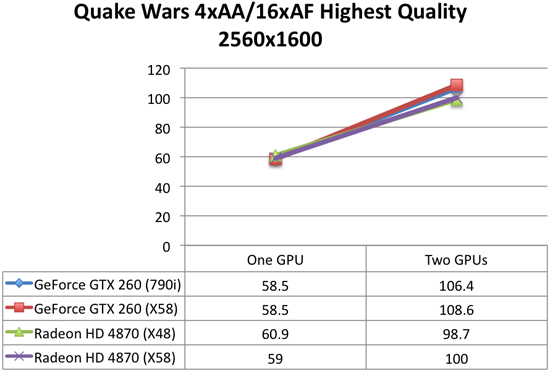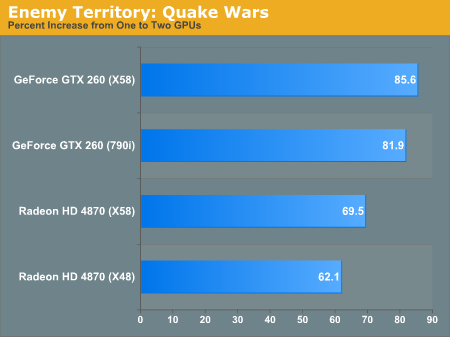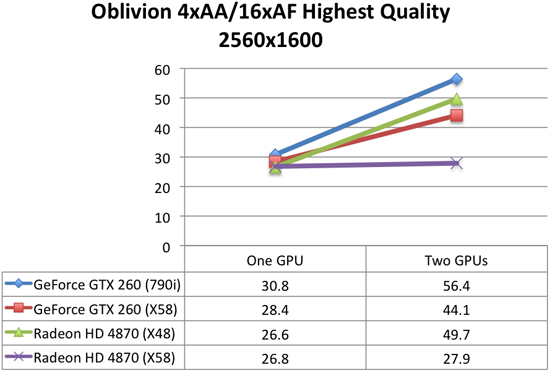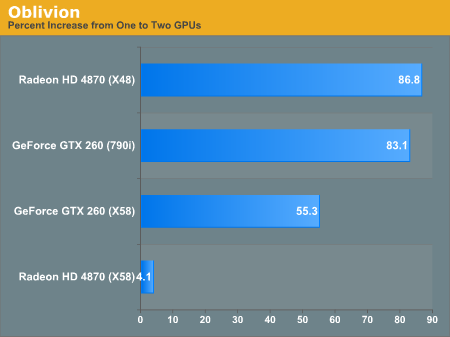The Dark Knight: Intel's Core i7
by Anand Lal Shimpi & Gary Key on November 3, 2008 12:00 AM EST- Posted in
- CPUs
X58 Multi-GPU Scaling
While we had some hope earlier in the year of unifying our SLI and CrossFire testbed under Skulltrail, we had to scrap that project due to numerous difficulties in testing. Today, we have another ray of hope. Having a single platform that will allow us to run both SLI and CrossFire would give us better ability to compare multiGPU scaling as there would be fewer variables to consider.
So we did a few tests today to see how the new X58 platform handles multiGPU scaling. We have compared CrossFire on X48 and SLI on 790i to multiGPU scaling on X58 in Oblivion and Quake Wars to get a taste of what we should expect. And the results are a bit of a mixed bag.


With Enemy Territory: Quake Wars, we see very consistent performance. Our single card numbers were very close to the numbers we saw on other platforms, and the general degree of scaling was maintained. Both NVIDIA and AMD hardware scaled slightly better on X58 here than on the hardware we had been using. This is a good sign that the potential for accurate comparison and good quality multiGPU testing might be possible on X58 going forward.
But there there's the Oblivion test.

Under Oblivion, NVIDIA hardware scaled less on X58, and our AMD tests were ... let's say inconclusive.

We have often had trouble with AMD drivers, especially when looking at CrossFire performance. The method that AMD uses to maintain and test their drivers necessitates eliminating some games from testing for extended periods of time. This can sometimes result in games that used to work well with AMD hardware or scale well with CrossFire to stop performing up to par or to stop scaling as well as they should.
The consistent fix, unfortunately, has been for review sites to randomly stumble upon these problems. We usually see resolutions very quickly to issues like this, but that doesn't change the fact that it shouldn't happen in the first place.
In any event, the past couple weeks have been more frustrating than usual when testing AMD hardware. We've switched drivers 4 different times in testing, and we still have issues. Yes, 3 of these four drivers have been hotfix beta drivers, but for people with Far Cry 2 the hotfix is all they've got, which is still broken even after three tries.
We certainly know that NVIDIA doesn't have it all right when it comes to drivers. But we really feel like AMD's monthly driver release schedule wastes resources on unnecessary work that could be better used to benefit their customers. If we are going to have hotfix drivers come out anyway, we might as well make sure that every full release incorporates all the fixes in every hot fix and doesn't break anything the last driver fixed.
The point of all this is, our money is on a lack of scaling under Oblivion due to some aspect of this beta driver we are using rather than scaling on X58.
As for the NVIDIA results, we're a little more worried about those. It could be that we are also seeing a driver issue here, but it just could be that Oblivion does something that doesn't scale well with SLI on X58. We were really surprised to see this as we expected comparable scaling. As the driers mature, we'll definitely test the issue of multiGPU scaling on X58 further.










73 Comments
View All Comments
anand4happy - Sunday, February 8, 2009 - link
saw many thing but this is the thing something dfferentsd4us.blogspot.com/2009/01/intel-viivintel-975x-express-955x.html
nidhoggr - Monday, November 10, 2008 - link
I cant find that information on the test setup page.nidhoggr - Monday, November 10, 2008 - link
test not text :)puffpio - Wednesday, November 5, 2008 - link
would you guys consider rebenchmarking?from the x264 changelog since the nehalem specific optimizations:
"Overall speed improvement with Nehalem vs Penryn at the same clock speed is around 40%."
anartik - Wednesday, November 5, 2008 - link
Good review and better than Tom's overall. However Tom's stumbled on something that changed my mind about gaming with Nehalem. While Anand's testing shows minimal performance gains (and came to the not good for games conclusion) Tom's approached it with 1-4 GPU's SLI or Crossfire. All I can say is the performance gains with Nvidia cards in SLI was stunning. Maybe the platform favors SLI or Nvidia had a driver advantage in licensing SLI to Intel. Either way Nehalem and SLI smoked ATI and the current 3.2 extreme quad across the board.dani31 - Wednesday, November 5, 2008 - link
I know it would't change any conclusion, but since we discuss bleeding edge Intel hardware it would have been nice to see the same in the AMD testbed.Using a SB600 mobo (instead of the acclaimed SB750) and an old set of drivers makes it look like the AMD numbers were simply pasted from an old article.
Casper42 - Tuesday, November 4, 2008 - link
Something I think you guys missed in your article/conslusion is the fact that we're now able to pair a great CPU with a pretty damn good North/South Bridge AND SLI.I found that the 680/780/790 featureset is plainly lacking and that the Intel ICH9R/10R seems to always perform better and has more features. If any doubt, look at Matrix RAID vs nVidia's RAID. Night and day difference, especially with RAID5.
The problem with the X38/X48 was you got a great board but were effectively locked into ATI for high end Gaming.
Now we have the best of both worlds. You get ICH10R, a very well performing CPU (even the 920 beats most of the Intel Quad Core lineup) AND you can run 1/2/3 nVidia GPUs on the machine. In my opinion, this is a winning combination.
The only downside I see is board designs seem to suck more and more.
With socket 1366 being so massive and 6 DIMM slots on the Enthusiast/Gamer boards, we're seeing not only 6 expansion slots (down from the standard of 7) but in most boards I have seen pics of, the top slot is an x1 so they can wedge it next to the x58 IOH which means your left with only 5 slots for other cards. Using 3 dual slot cards is out of the question without a massive 10 slot case (of which there are only like 3-5 on the market) and even if you can wedge 2 or 3 dual slot cards into the machine, you have almost zero expansion card slots should you ever need them.
Then we get to all the cooling crap surrounding the CPU. ALL these designs rely on a top down traditional cooler and if you decide to use a highly effective tower cooling solution, all the little heatsink fins on the Northbridge and pwer regulators around the CPU get very little or no airflow. Now your in there adding puny little 40/60mm fans that produce more noise than airflow, not to mention that the DIMMs are hardly ever cooled in today's board designs.
Call me a cooling purist if you will, but I much prefer traditional front to back airflow and all this side intake top exhaust stuff just makes me cringe. I personally run a Tyan Thunder K8WE with 2 Hyper6+ coolers and the procs and RAM are all cooled front to back. Intake and exhaust are 120mm and I have a bit of an air channel in which that airflow never goes near the expansion card slots below, which by the way have a 92mm fan up front pushing air in across the drives and another 92mm fan clipped onto the expansion slots in the back pulling it back out.
I dont know how to resolve these issues, but I think someone surely needs to because IMHO its getting out of control.
lemonadesoda - Tuesday, November 4, 2008 - link
"Looking at POV-Ray we see a 30% increase in performance for a 12% increase in total system power consumption, that more than exceeds Intel's 2:1 rule for performance improvement vs. increase in power consumption."You cant use "total system power", but must make the best estimate of CPU power draw. Why? Because imagine if you had a system with 6 sticks of RAM, 4 HDDs, etc. you would have ever increasing power figures that would make the ratio of increased power consumption (a/b) smaller and smaller!
If you take your figures and subtract (a guestimate of) 100W for non CPU power draw, then you DONT get the Intel 2:1 ratio at all!
The figures need revisiting.
AnnonymousCoward - Thursday, November 6, 2008 - link
Performance vs power appears to linearly increase with HT. Using the 100W figure for non-CPU draw means a 25% power increase, which is close to the 30% performance.Unless we're talking about servers, I think looking at power draw per application is silly. Just do idle power, load power, and maybe some kind of flops/watt benchmark just for fun.
silversound - Tuesday, November 4, 2008 - link
great article, tomsharware reviews always pro intel and nvidia, not sure if they got pay $ to suppot them. anandtech is always neutral, thx!